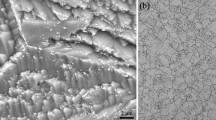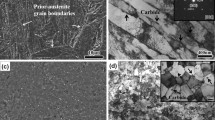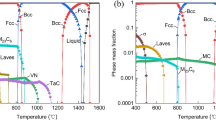Abstract
The China Low Activation Martensitic (CLAM) steel is one of 9Cr martensitic steels, and it has been selected as the primary candidate structural material for future fusion reactors in China. It is essential to understand the thermal stability of CLAM steel to ensure the operation safety during exposures at operating temperatures. In this paper, the thermal aging behavior of CLAM steel at 550 °C for 20000 h was studied. Microstructure evolution and mechanical property change were investigated. The results showed that Laves phase was mainly precipitated along the martensitic lath boundaries and grain boundaries in CLAM samples after aging for more than 4000 h, and its size increased faster than that of M23C6. The size of TaC had no obvious changed but its number increased after aging. The microstructure evolution resulted to degradation of the mechanical property, especially the ductile-to-brittle transition temperature (DBTT), which was increased from − 92 to − 43 °C after aging for 20000 h. The possible mechanism of DBTT increasing had been analyzed based on the interaction between precipitations and grain boundaries.






Similar content being viewed by others
References
Huang Q, Li C, Li Y, Chen M, Zhang M, Peng L, Zhu Z, Song Y, Gao S (2007) Progress in development of China low activation martensitic steel for fusion application. J Nucl Mater 267–370:142–146
Lindau R, Möslang A, Rieth M, Klimiankou M, Materna-Morris E, Alamo A, Tavassoli A, Cayron C, Lancha A, Fernandez P, Baluc N, Schäublin R, Diegele E, Filacchioni G, Rensman J, Schaaf B, Lucon E, Dietz W (2005) Present development status of EUROFER and ODS-EUROFER for application in blanket concepts. Fusion Eng Des 75–79:989–996
Marmy P, Oliver B (2003) High strain fatigue properties of F82H ferritic-martensitic steel under proton irradiation. J Nucl Mater 318:132–142
Ehrlich K (2001) Materials research towards a fusion reactor. Fusion Eng Des 56–57:71–82
Huang Q, Li C, Wu Q, Liu S, Gao S, Guo Z, Yan Z, Huang B, Song Y, Zhu Z, Chen Y (2011) Progress in development of CLAM steel and fabrication of small TBM in China. J Nucl Mater 417:85–88
Huang Q, Wu Y, Li J, Wan F, Chen J, Luo G, Liu X, Chen J, Xu Z, Zhou X, Ju X, Shan Y, Yu J, Zhu S, Zhang P, Yang J, Chen X, Dong S (2009) Status and strategy of fusion materials development in China. J Nucl Mater 386–388:400–404
Huang Q, Team FDS (2014) Development status of CLAM steel for fusion application. J Nucl Mater 445:649–654
Liu S, Huang Q, Li C, Huang B (2009) Influence of non-metal inclusions on mechanical properties of CLAM steel. Fusion Eng Des 84:1214–1218
Li Y, Huang Q, Wu Y, Nagasaka T, Muroga T (2007) Mechanical properties and microstructures of China low activation martensitic steel compared with JLF-1. J Nucl Mater 367–370:117–121
Huang Q, Gao S, Zhu Z, Zhang M, Song Y, Li C, Chen Y, Ling X, Zhou X, Team FDS (2009) Progress in compatibility experiments on lithium-lead with candidate structural materials for fusion in China. Fusion Eng Des 84:242–246
Wu Y, Huang Q, Zhu Z, Gao S, Song Y (2012) R&D of dragon series lithium lead loops for material and blanket technology testing. Fusion Eng Des 62:272–275
Gao S, Huang Q, Zhu Z, Guo Z, Ling X, Chen Y (2011) Corrosion behavior of CLAM steel in static and flowing LiPb at 480 °C and 550 °C. Fusion Eng Des 86:2627–2631
Li C, Huang Q, Wu Q, Liu S, Lei Y, Muroga T, Nagasaka T, Zhang J, Li J (2009) Welding techniques development of CLAM steel for test blanket module. Fusion Eng Des 84:1184–1187
Huang Q, Li J, Chen Y (2004) Study of irradiation effects in China low activation martensitic steel CLAM. J Nucl Mater 329:268–272
Wu Y, Team FDS (2007) Conceptual design and testing strategy of a dual functional lithium-lead test blanket module in ITER and EAST. Nucl Fusion 47–11:1533–1539
Wu Y, Team FDS (2007) Design analysis of the China dual-functional lithium lead (DFLL) test blanket module in ITER. Fusion Eng Des 82:1893–1903
Wu Y, Chen Z, Hu L et al (2016) Identification of safety gaps for fusion demonstration reactors. Nat Eenery. https://doi.org/10.1038/NENERY.2016.154
Fernandez P, Garcia-Mazario M, Lancha A, Lapena J (2004) Grain boundary microchemistry and metallurgical characterization of Eurofer’97 after simulated service conditions. J Nucl Mater 329–333:278–282
Fernandez P, Lancha A, Lapena J, Serrano M, Hernandez-Mayoral M (2002) Metallurgical properties of reduced activation martensitic steel Eurofer’97 in the as-received condition and after thermal ageing. J Nucl Mater 307–311:495–499
Shiba K, Tanigawa H, Hirose T, Sakasegawa H, Jitsukawa S (2011) Long-term properties of reduced activation ferritic/martensitic steels for fusion reactor blanket system. Fusion Eng Des 86:2895–2899
Hu X, Huang L, Yan W, Wang W, Sha W, Shan Y, Yang K (2013) Evolution of microstructure and changes of mechanical properties of CLAM steel after long-term aging. Mater Sci Eng A 586:253–258
ASTM E23-12c, Standard Test Methods for Notched Bar Impact Testing of Metallic Materials, ASTM International, USA
Wang W, Liu S, Xu G, Zhang B, Huang Q (2016) Effect of thermal aging on microstructure and mechanical properties of China low-activation martensitic steel at 550 °C. Nucl Eng Technol 48(2):518–524
Huang L, Hu X, Yang C, Yan W, Xiao F, Shan Y, Yang K (2013) Influence of thermal aging on microstructure and mechanical properties of CLAM steel. J Nucl Mater 443:479–483
Sakasegawa H, Tanigawa H, Kano S, Enomoto M (2011) Precipitation behavior in F82H during heat treatment of blanket fabrication. Fusion Eng Des 86:2541–2544
Tamura M, Shinozuka K, Esaka H, Sugimoto S, Ishizawa K, Masamura K (2000) Mechanical properties of 8Cr-2WVTa steel aged for 30000h. J Nucl Mater 283–287:667–671
Song M, Zhu R, Foley DC, Sun C, Chen Y, Hartwing KT, Zhang X (2013) Enhancement of strength and ductility in untrafine-grained T91 steel through thermomechanical treatments. J Mater Sci 48(21):7360–7373. https://doi.org/10.1007/s10853-013-7522-3
Watanabe T (2011) Grain boundary engineering: historical perspective and future prospects. J Mater Sci 46(12):4095–4115. https://doi.org/10.1007/s10853-011-5393-z
Wan Q, Wang R, Shu G, Ding H, Huang P, Lv F, Wang L (2011) Analysis method of Charpy V-notch impact data before and after electron beam welding reconstitution. Nucl Eng Des 241:459–463
Friedel J (1964) Dislocation, 1st edn. Pergamon Press, London
Russell K, Brown L (1972) A dispersion strengthening model based on differing elastic moduli applied to the iron-copper system. Acta Metall Mater 20:969–974
Harry T, Bacon D (2002) Computer simulation of the core structure of the <111> screw dislocation in alpha-iron containing copper precipitates: I. Structure in the matrix and a precipitate. Acta Mater 50:195–208
Harry T, Bacon D (2002) Computer simulation of the core structure of the <111> screw dislocation in alpha-iron containing copper precipitates: II. Dislocation-precipitate interaction and the strengthening effect. Acta Mater 50:209–222
Fine M, Vaynman S, Isheim D, Chung Y, Bhat S, Hahin C (2010) A new paradigm for designing high-fracture-energy steels. Metall Mater Trans A 41:3318–3325
Ghosh A, Ray A, Chakrabarti D, Davis C (2013) Cleavage initiation in steel: competition between large grains and large particles. Mater Sci Eng A 561:126–135
Wang W, Chen J, Xu G (2017) Effect of thermal aging on grain structural characteristic and Ductile-to-Brittle transition temperature of CLAM steel at 550 °C. Fusion Eng Des 115:74–79
Acknowledgements
This work was supported by the National Magnetic Confinement Fusion Science Program of China with Grant Nos. 2014GB112003 and 2015GB109006, the National Science Foundation of China with Grant No. 11632001, the Foundation of President of Hefei Institutes of Physical Science with Grant No. YZJJ201519, the Youth Innovation Promotion Association CAS with Grant Nos. 2017486, and the CAS Pioneer Hundred Talents Program. The authors thank Prof. Yican Wu for the guidance on this work and show great appreciation to other members in FDS Team for their support and contribution to this research.
Author information
Authors and Affiliations
Corresponding author
Rights and permissions
About this article
Cite this article
Wang, W., Mao, X., Liu, S. et al. Microstructure evolution and toughness degeneration of 9Cr martensitic steel after aging at 550 °C for 20000 h. J Mater Sci 53, 4574–4581 (2018). https://doi.org/10.1007/s10853-017-1868-x
Received:
Accepted:
Published:
Issue Date:
DOI: https://doi.org/10.1007/s10853-017-1868-x




